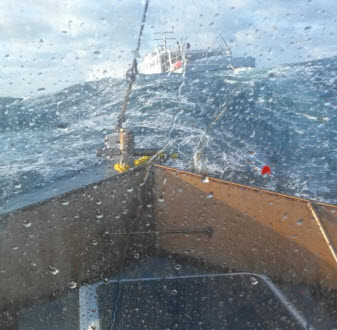U.S. Coast Guard's Medical Training Questioned
The U.S. National Transportation Safety Board (NTSB) has issued recommendations to the U.S. Coast Guard about emergency medical training of crews after the death of a fisherman in 2015.
The 51-foot-long fishing vessel Orin C sank on December 3, 2015 in about 300 feet of water, approximately 13 nautical miles east of Cape Ann, Massachusetts. Disabled by an engine failure, the Orin C was taken in tow by a good Samaritan fishing vessel, the Foxy Lady. While in tow, the Orin C sustained damage from a large wave, and the damage contributed to the flooding on the vessel. Seas of five to eight feet and winds of 20 to 25 knots battered the Orin C while it was in tow.
 A Coast Guard 47-foot motor lifeboat was later dispatched to assist and took the Orin C in tow as the waves grew to eight to 10 feet and winds exceeded 30 knots. Dewatering efforts could not keep pace with the rate of flooding and the decision was made to abandon the Orin C.
A Coast Guard 47-foot motor lifeboat was later dispatched to assist and took the Orin C in tow as the waves grew to eight to 10 feet and winds exceeded 30 knots. Dewatering efforts could not keep pace with the rate of flooding and the decision was made to abandon the Orin C.
All three Orin C crewmembers entered the water; two safely swam to the awaiting Coast Guard lifeboat. The Captain, David “Heavy D” Sutherland, aged 47, made three distinct swimming strokes, and then his movements ceased. He could be seen floating on his back with his head submerged under the waves.
Recognizing the captain was unconscious, a motor lifeboat crewmember, wearing a dry suit, donned swimming gear and entered the water with a lifeline. He swam to the captain and took hold of him. Both were pulled back to the motor lifeboat. Sutherland had no pulse and was not breathing when brought aboard, and the lifeboat crew immediately began CPR.
A Coast Guard helicopter was dispatched to assist, but attempts to lower a rescue swimmer to the motor lifeboat with an automated external defibrillator and emergency medical technician kit were unsuccessful. It was determined there was too much risk to continue those attempts due to the sea conditions.
CPR continued for more than an hour until a Coast Guard flight surgeon recommended ceasing resuscitation efforts. Sutherland was transferred to emergency medical services in Gloucester, Massachusetts, where he was pronounced dead.
Medical Case
The captain had an enlarged heart with severe thickening of the left ventricle and some thickening of the right ventricle, as well as slight to moderate coronary artery disease. The enlargement may have been the result of obesity and/or hypertension. Both findings placed him at increased risk for an acute cardiac event such as a heart attack, arrhythmia, or sudden cardiac death.
The strain of the prolonged exposure to the cold, wet environment; the shock of entering the water and the physical exertion of swimming, along with stress of losing his vessel, increased the likelihood that the captain suffered an acute event, says the NTSB. While these factors may have contributed to the captain’s loss of consciousness that led to his drowning, the exact cause could not be determined.
The NTSB report states that it is unlikely that use of an automated external defibrillator would have saved Sutherland’s life.
Drowning victims can sometimes be saved if they’re underwater for only a few minutes and receive oxygen immediately. The lifeboat had advanced emergency first-aid kit including an oxygen tank and associated equipment such as tubing and masks. However, none of the crew on board had the training to use much of the equipment in the kit.
Coast Guard officials, referencing the Coast Guard Emergency Medical Services Manual, stated that boat crews are supplemented with personnel with a higher level of medical training when responding to designated medical emergencies. At the time the motor lifeboat was dispatched to aid the Orin C, the mission was to assist a stricken fishing vessel; there were no reports of injuries or specific medical requests.
The NTSB report states that it is unclear if the presence of a crewmember with advanced first-aid training on board would have saved Sutherland’s life.
Recommendations
Nonetheless, the NTSB made two recommendations to the U.S. Coast Guard as a result of the investigation:
1. Ensure that, at all times, at least one crewmember on board each type of response boat is adequately trained in the types of medical emergencies expected in a marine environment and qualified in the use of all first-aid and/or trauma equipment carried on board.
2. Develop a standard for the contents of first-aid and trauma kits for each type of Coast Guard response vessel.
The report is available here.
The opinions expressed herein are the author's and not necessarily those of The Maritime Executive.
